Planning of Flexible Generators and Energy Storages under High Penetration of Renewable Power in Taiwan Power System
Abstract
:1. Introduction
- (1)
- A Taiwan power grid with realistic renewable energy generation is modeled as a stochastic unit scheduling problem. Resources covering all the generation, load demand, pumped storage, hydro generation, future flexible ICEs, and energy storage installations are included. This system allows researchers to comprehensively explore the effect of generation flexibility on the future Taiwan power grid, especially for the operating cost of unit scheduling.
- (2)
- Flexible ICEs and energy storages are considered as potential resources to provide generation flexibility, and the flexibility index is quantified by utilizing the fuzzy analytic hierarchy process method.
- (3)
- Sensitivity analysis has been simulated with four seasons that have different scenarios for renewable power generation. It provides a comprehensive study of the effect of generation flexibility on the operation cost of unit scheduling.
- (4)
- Lastly, in conjunction with the growth in generation flexibility, the proposed framework manages to precisely identify the appropriate and optimal capacities for flexible ICEs and energy storage installations, which is essential for future Taiwan power system planning.
2. Renewable Energy Efforts in Various Contexts
3. Calculation of Flexible Indexes
4. Unit Scheduling and Economic Dispatch
4.1. Stochastic Unit Scheduling
4.2. Economic Dispatch
5. High Percentage of Renewable Energy Scenarios Analyzed and Simulated
5.1. Unit Scheduling in Spring
5.2. Unit Scheduling in Summer
5.3. Unit Scheduling in Autumn
5.4. Unit Scheduling in Winter
5.5. Comprehensive Discussions
- 1.
- Taiwan has the most challenging unit-scheduling work in autumn, when both wind and solar power outputs operate at almost full capacity, resulting in a net load that is close to zero during the midday period and a high requirement for power ramp-up in the evening. The average unit-scheduling cost in autumn is also the highest among all seasons.
- 2.
- As more flexible units are installed, unit-scheduling costs will be further reduced. However, in terms of economics efficiency, it is not always necessary to increase the capacity of ICE flexible units as much as possible. It is also essential to enhance the forecast accuracy for renewable energy variations and decide an appropriate capacity of flexible units.
- 3.
- For arranging the capacity of energy storages, although a large capacity of storages can reduce unit-scheduling costs in most scenarios, integrating 0.5 GW of energy storage capacity is sufficient for saving most of the dispatching costs and obtaining the most efficient dispatching result. Furthermore, the simulation results also demonstrate that appropriate energy storages effectively provide operating reserves, thus further reducing a shortage of reserve requirements and renewable energy curtailment.
- 4.
- In the future, the integration of large amounts of renewable energy sources will significantly change the current operation strategy on pumped storage units in Taiwan. This study reveals that the period of pumping water into upper reservoir is charged to the peak-load period during the daytime, while the period for generating power is shifted to evening or night.
6. Conclusions
Author Contributions
Funding
Conflicts of Interest
References
- Mohandes, B.; Moursi, M.S.E.; Hatziargyriou, N.; Khatib, S.E. A Review of Power System Flexibility with High Penetration of Renewables. IEEE Trans. Power Syst. 2019, 34, 3140–3155. [Google Scholar] [CrossRef]
- Wu, Y.-K.; Tan, W.-S.; Huang, S.-R.; Chiang, Y.-S.; Chiu, C.-P.; Su, C.-L. Impact of generation flexibility on the operating costs of the Taiwan power system under a high penetration of renewable power. IEEE Trans. Ind. Appl. 2020, 56, 2348–2359. [Google Scholar] [CrossRef]
- Pourahmadi, F.; Heidarabadi, H.; Hosseini, S.H.; Dehghanian, P. Dynamic Uncertainty Set Characterization for Bulk Power Grid Flexibility Assessment. IEEE Syst. J. 2020, 14, 718–728. [Google Scholar] [CrossRef]
- Ghaljehei, M.; Khorsand, M. Day-Ahead Operational Scheduling with Enhanced Flexible Ramping Product: Design and Analysis. IEEE Trans. Power Syst. 2022, 37, 1842–1856. [Google Scholar] [CrossRef]
- Khajeh, H.; Laaksonen, H.; Gazafroudi, A.S.; Shafie-khah, M. Towards Flexibility Trading at TSO-DSO-Customer Levels: A Review. Energies 2020, 13, 165. [Google Scholar] [CrossRef] [Green Version]
- Khoshjahan, M.; Moeini-Aghtaie, M.; Fotuhi-Firuzabad, M.; Dehghanian, P.; Mazaheri, H. Advanced bidding strategy for participation of energy storage systems in joint energy and flexible ramping product market. IET Gener. Transm. Distrib. 2020, 14, 5202–5210. [Google Scholar] [CrossRef]
- Khoshjahan, M.; Fotuhi-Firuzabad, M.; Moeini-Aghtaie, M.; Dehghanian, P. Enhancing electricity market flexibility by deploying ancillary services for flexible ramping product procurement. Electr. Power Syst. Res. 2021, 191, 106878. [Google Scholar] [CrossRef]
- Nikoobakht, A.; Aghaei, J.; Shafie-Khah, M.; Catalão, J.P.S. Minimizing Wind Power Curtailment Using a Continuous-Time Risk-Based Model of Generating Units and Bulk Energy Storage. IEEE Trans. Smart Grid 2020, 11, 4833–4846. [Google Scholar] [CrossRef]
- Li, H.; Lu, Z.; Qiao, Y.; Zhang, B.; Lin, Y. The Flexibility Test System for Studies of Variable Renewable Energy Resources. IEEE Trans. Power Syst. 2021, 36, 1526–1536. [Google Scholar] [CrossRef]
- Lekvan, A.A.; Habibifar, R.; Moradi, M.; Khoshjahan, M.; Nojavan, S.; Jermsittiparsert, K. Robust optimization of renewable-based multi-energy micro-grid integrated with flexible energy conversion and storage devices. Sustain. Cities Soc. 2021, 64, 102532. [Google Scholar] [CrossRef]
- Yuan, Y.; Shang, C. Planning of renewable sources and energy storages and retirement of coal plants with unit commitment reserving operational flexibility. In Proceedings of the 2021 IEEE Sustainable Power and Energy Conference (iSPEC), Nanjing, China, 23–25 December 2021; pp. 2282–2286. [Google Scholar]
- Chen, X.; Lv, J.; McElroy, M.B.; Han, X.; Nielsen, C.P.; Wen, J. Power system capacity expansion under higher penetration of renewables considering flexibility constraints and low carbon policies. IEEE Trans. Power Syst. 2018, 33, 6240–6253. [Google Scholar] [CrossRef]
- Deason, W. Comparison of 100% renewable energy system scenarios with a focus on flexibility and cost. Renew. Sustain. Energy Rev. 2018, 82, 3168–3178. [Google Scholar] [CrossRef]
- Internal Combustion Engine. Available online: https://www.wartsila.com/energy/learn-more/technical-comparisons (accessed on 13 June 2022).
- Tan, W.-S.; Shaaban, M.; Ab Kadir, M.Z.A. Stochastic generation scheduling with variable renewable generation: Methods, applications, and future trends. IET Gener. Transm. Distrib. 2019, 13, 1467–1480. [Google Scholar] [CrossRef] [Green Version]
- Hu, J.; Li, H. A new clustering approach for scenario reduction in multi-stochastic variable programming. IEEE Trans. Power Syst. 2019, 34, 3813–3825. [Google Scholar] [CrossRef]
- Du, E.; Zhang, N.; Kang, C.; Xia, Q. Scenario map based stochastic unit commitment. IEEE Trans. Power Syst. 2018, 33, 4694–4705. [Google Scholar] [CrossRef]
- Elia Grid Data. Available online: https://www.elia.be/en/grid-data (accessed on 13 June 2022).
- GAMS SCENRED2 Method. Available online: https://www.gams.com/latest/docs/T_SCENRED2.html (accessed on 13 June 2022).
- Oree, V.; Hassen, S.Z.S. A composite metric for assessing flexibility available in conventional generators of power systems. Appl. Energy 2016, 177, 683–691. [Google Scholar] [CrossRef]
- Shetaya, A.A.S.; El-Azab, R.; Amin, A.; Abdalla, O.H. Flexibility Measurement of Power System Generation for Real-Time Applications Using Analytical Hierarchy Process. In Proceedings of the 2018 IEEE Green Technologies Conference (GreenTech), Austin, TX, USA, 4–6 April 201; pp. 7–14.
- Ishizaka, A. Comparison of fuzzy logic, AHP, FAHP and hybrid fuzzy AHP for new supplier selection and its performance analysis. Int. J. Integr. Supply Manag. 2014, 9, 1–22. [Google Scholar] [CrossRef] [Green Version]
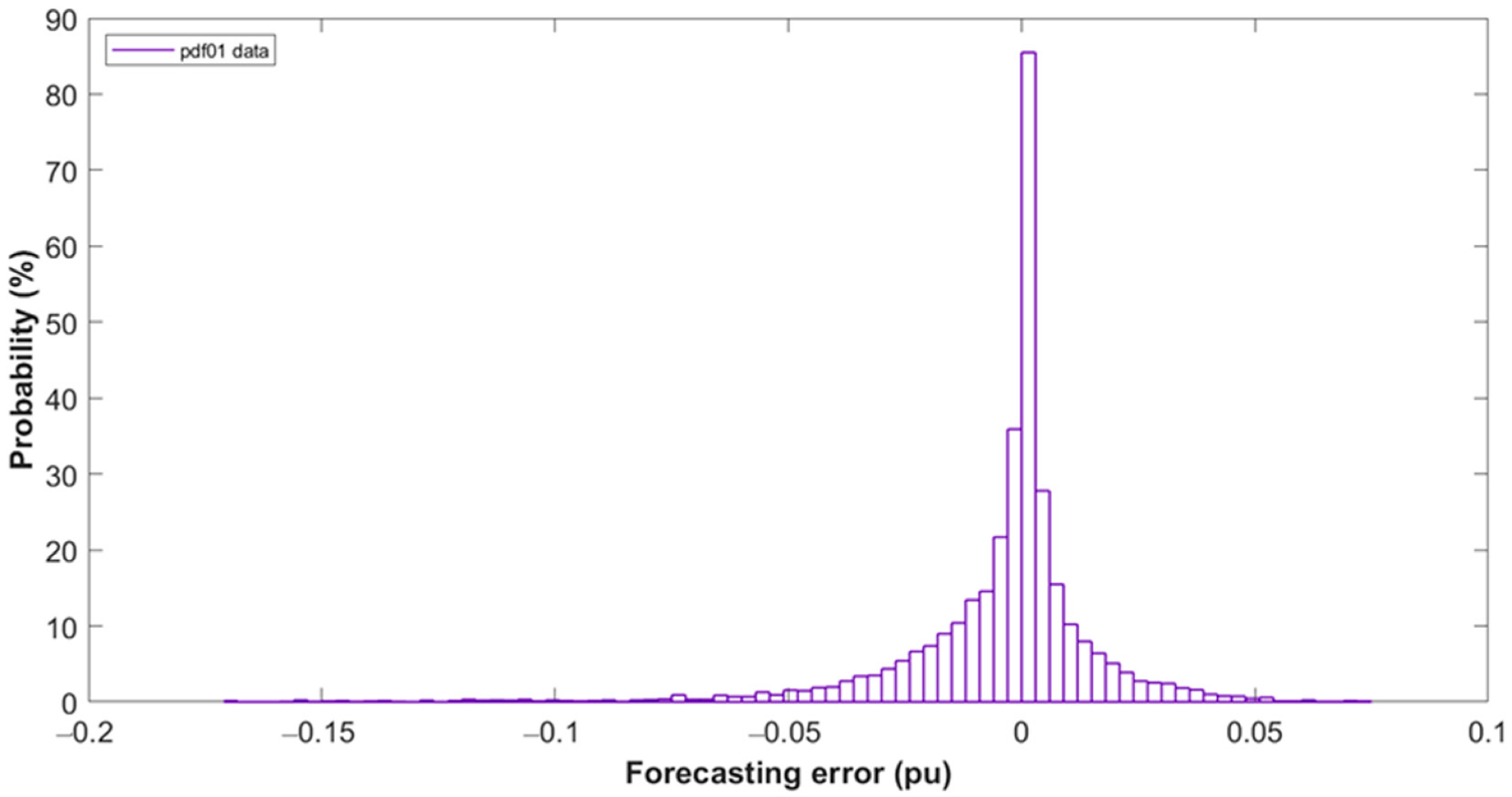
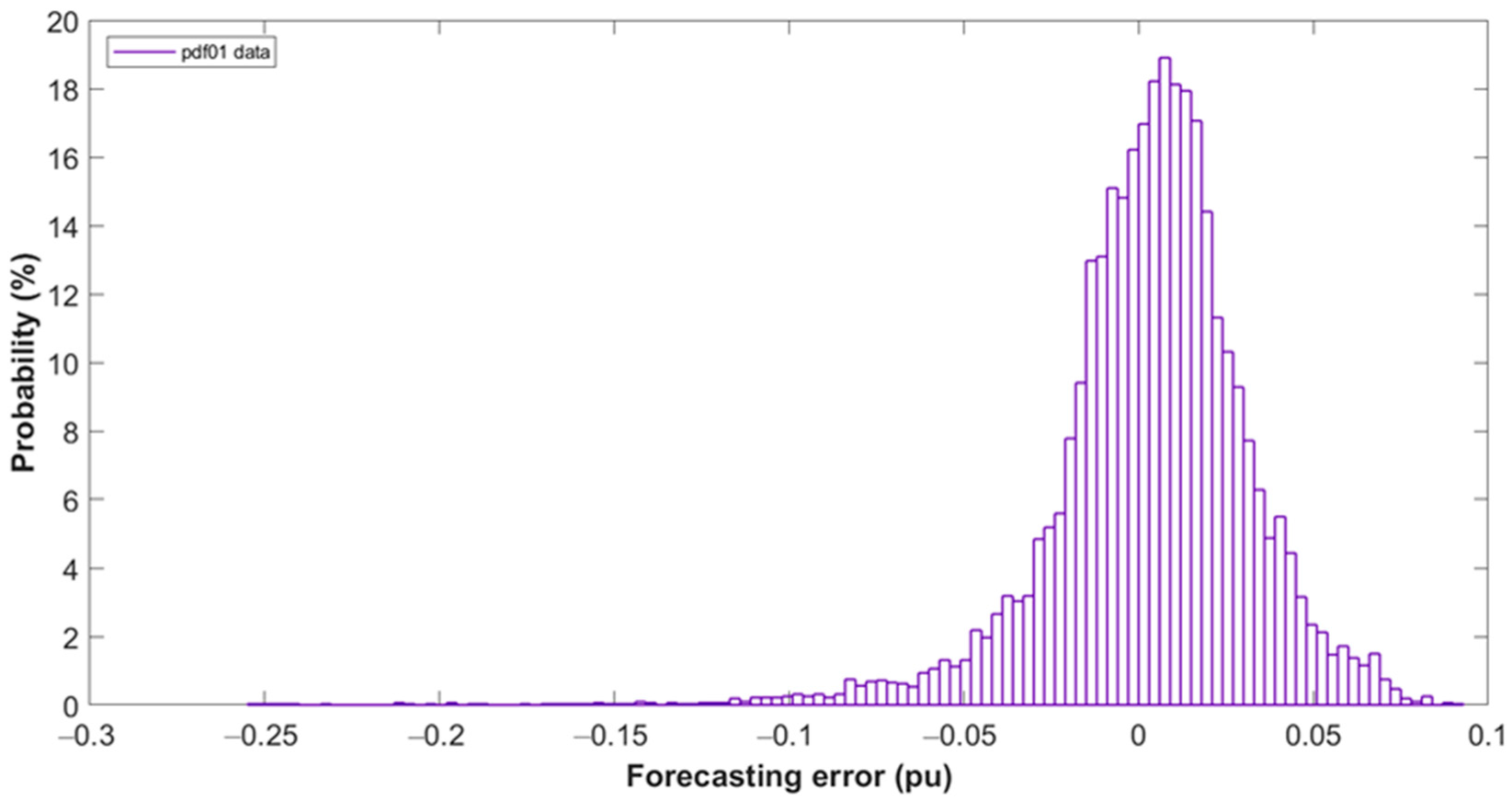
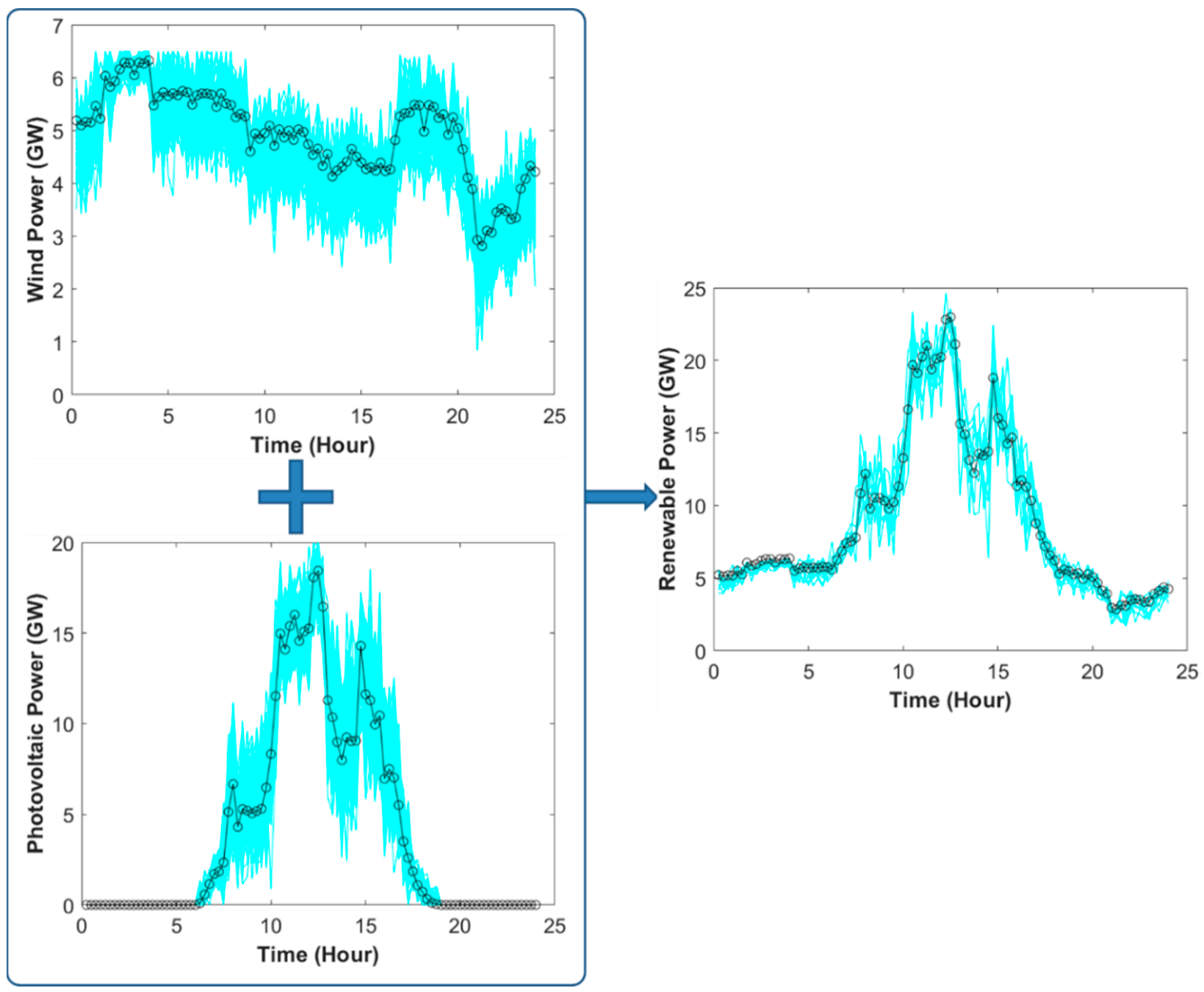

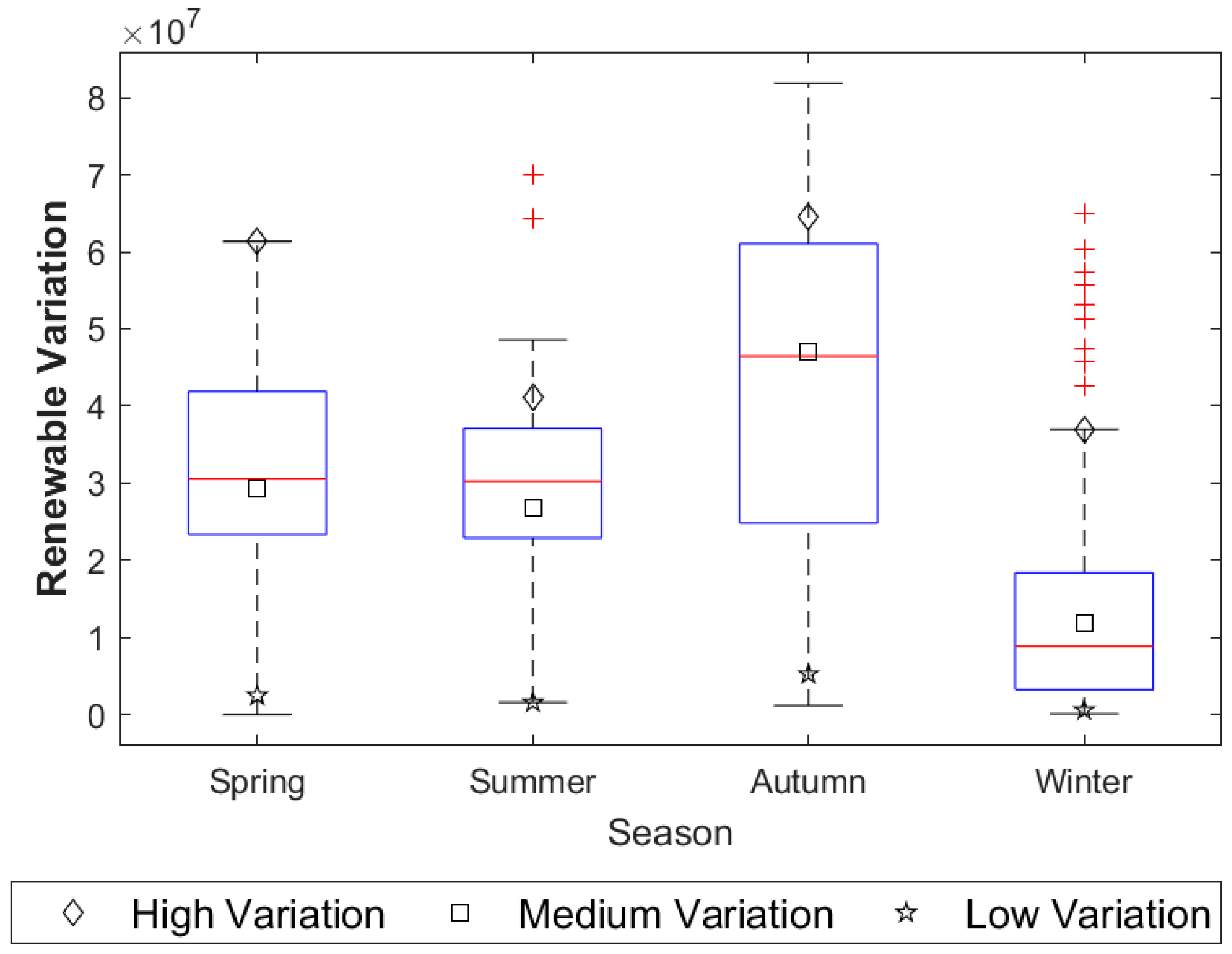
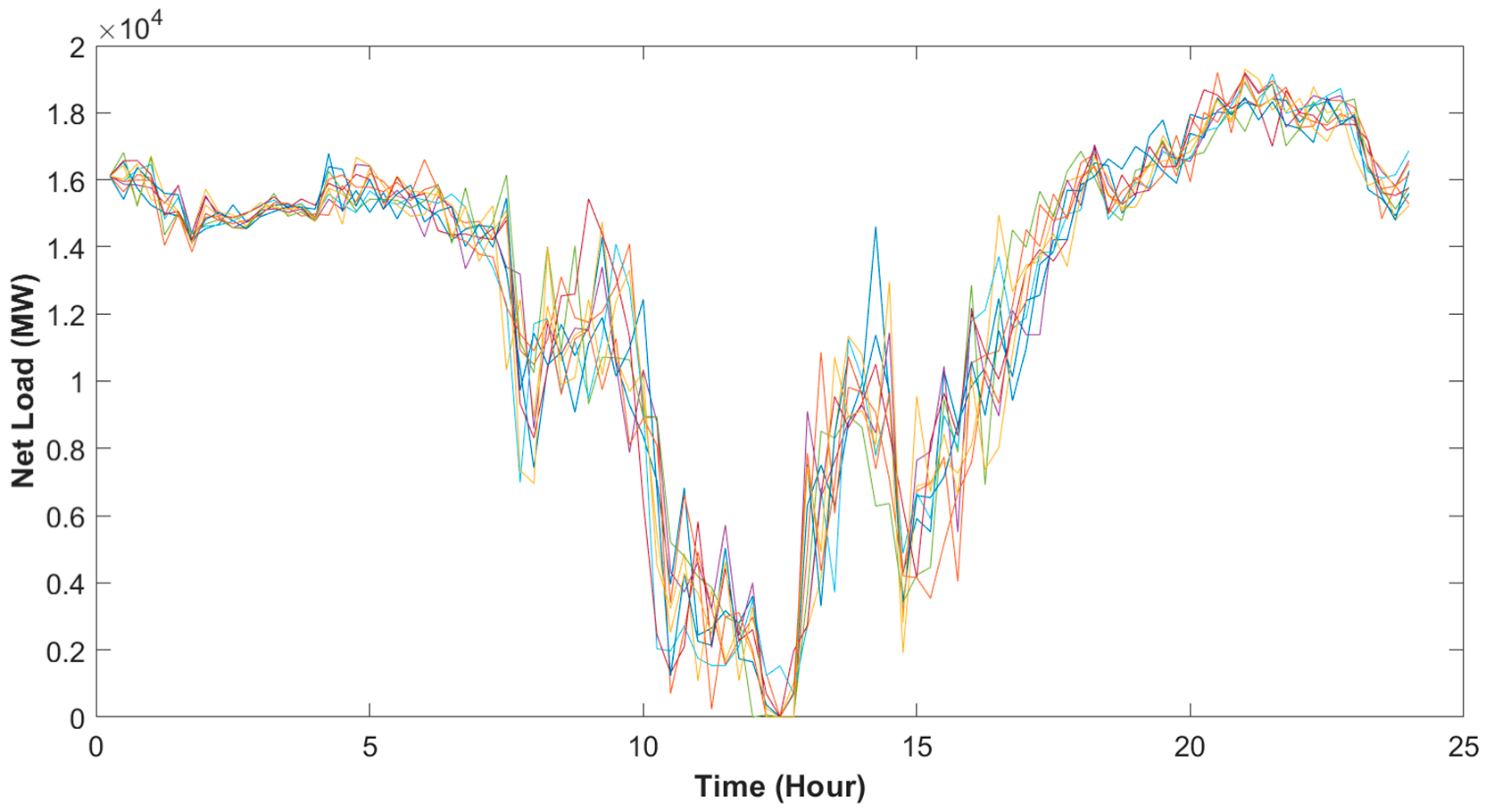

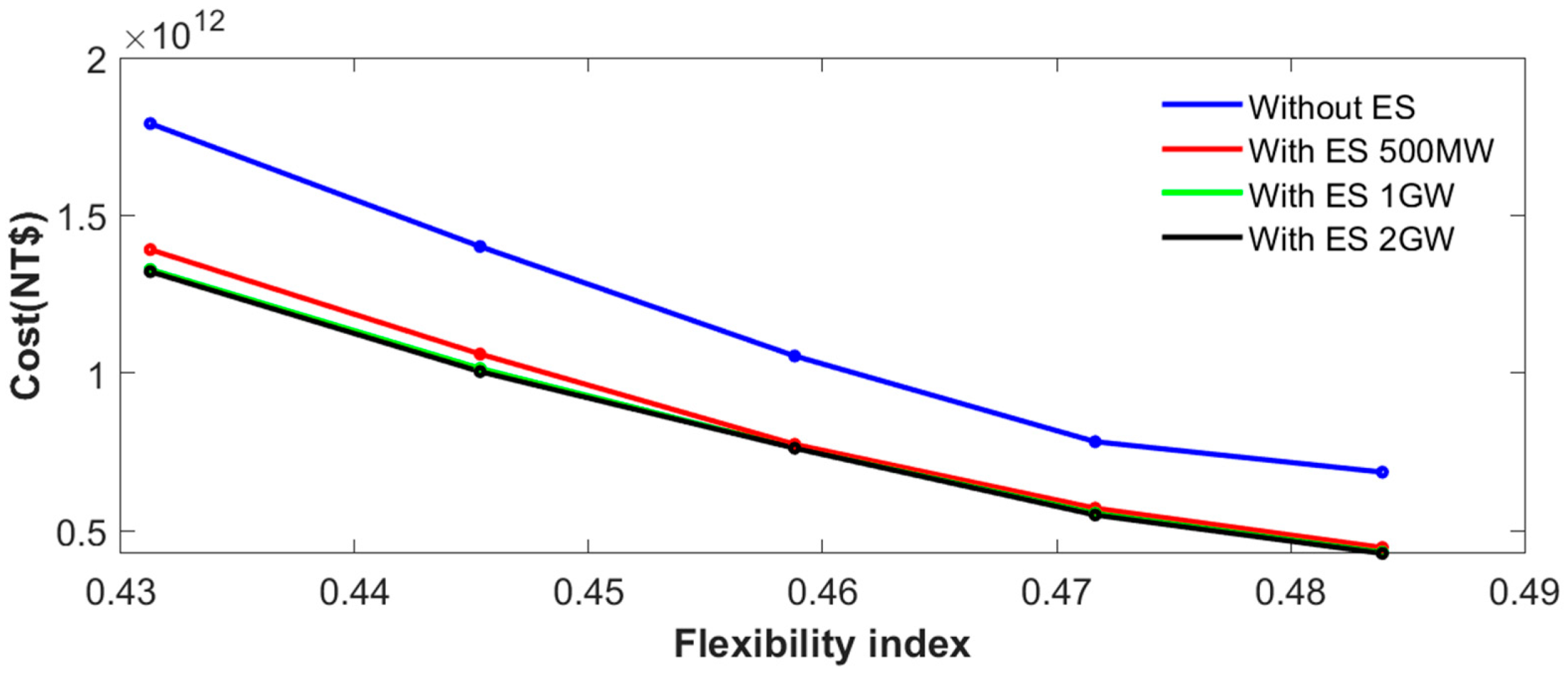




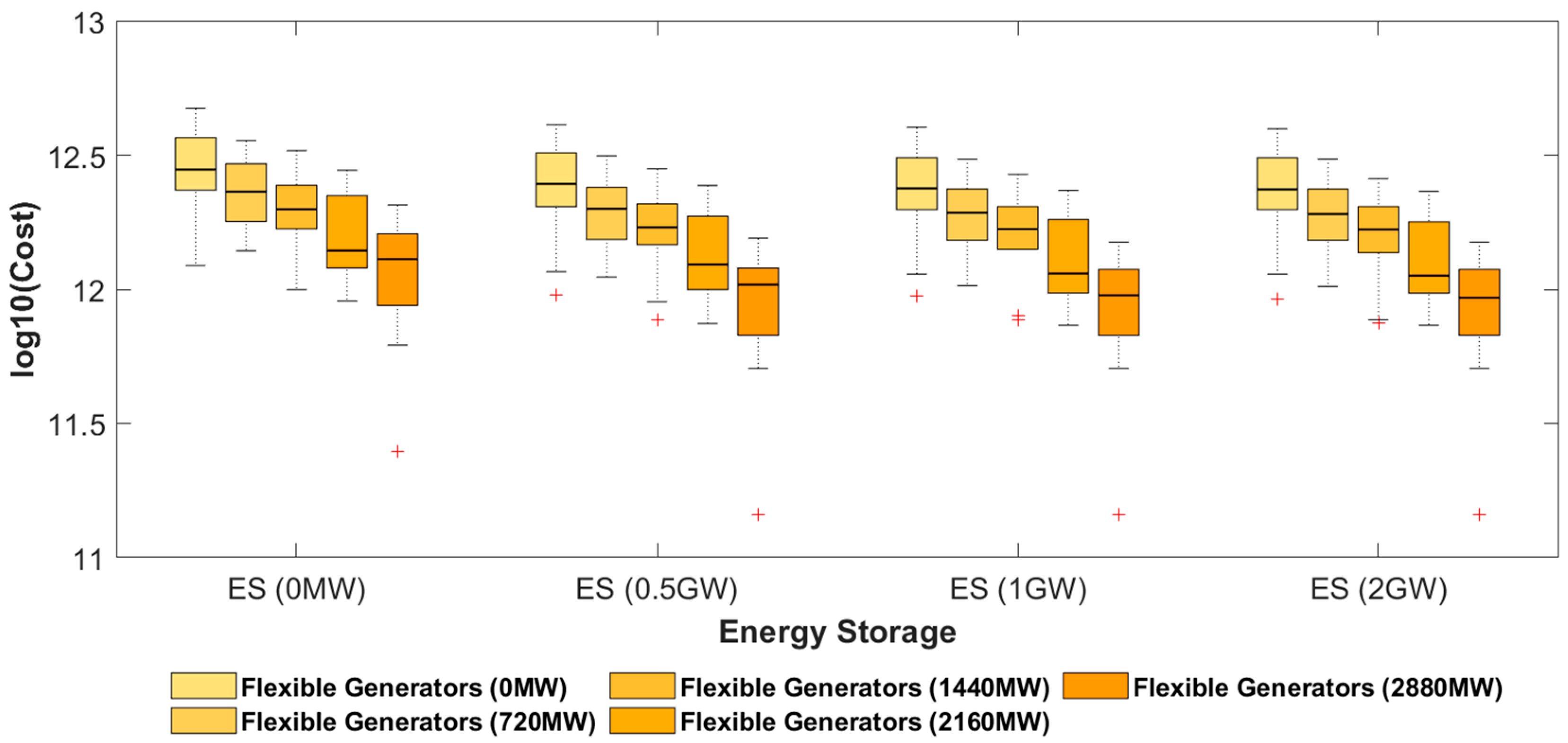
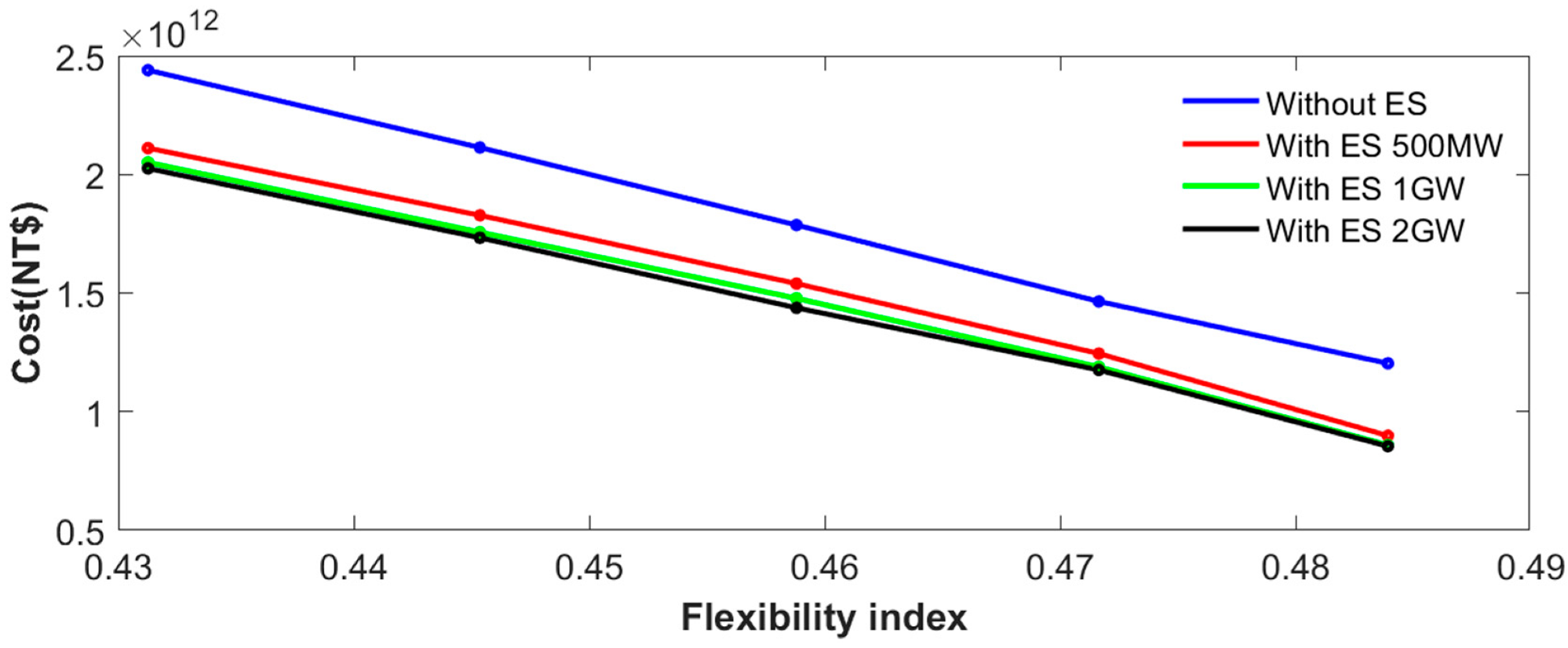

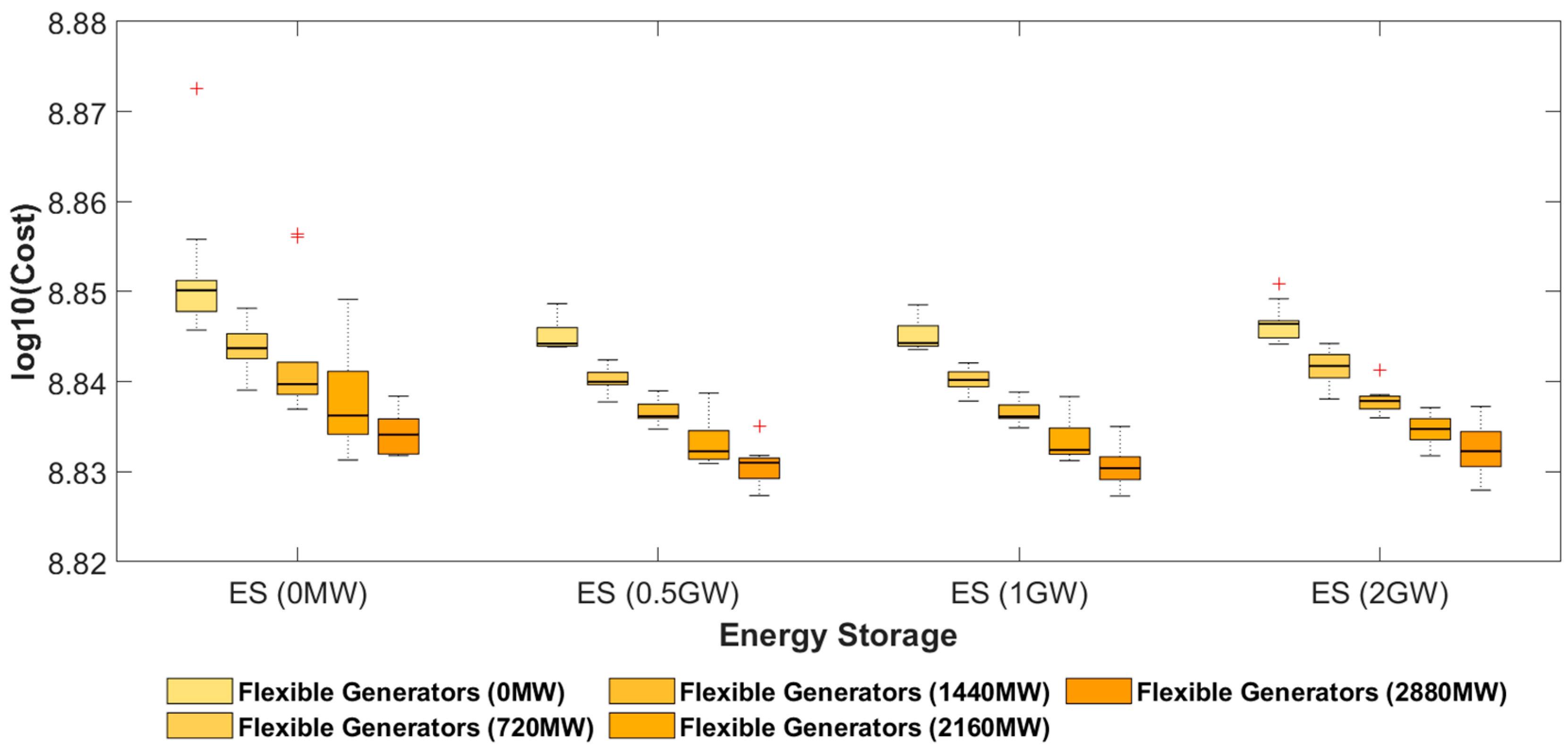

| Unit Type | Single Unit Capacity (MW) | Number of Units |
|---|---|---|
| 3 + 1 CCGT | 720 | 25 |
| 3 + 1 CCGT | 708 | 4 |
| 3 + 1 CCGT | 428.7 | 5 |
| 2 + 1 CCGT | 314.8 | 1 |
| 2 + 1 CCGT | 273 | 3 |
| Gas-fired | 249 | 1 |
| Gas-fired | 537.88 | 1 |
| Coal-fired | 525 | 10 |
| Unit Combination Case | Capacity of ICEs (MW) | Flexibility Index |
|---|---|---|
| 1 | 0 | 0.4313 |
| 2 | 720 | 0.4454 |
| 3 | 1440 | 0.4588 |
| 4 | 2160 | 0.4716 |
| 5 | 2880 | 0.4839 |
| Season | Variation | Scenario | |||||||||
|---|---|---|---|---|---|---|---|---|---|---|---|
| 1 | 2 | 3 | 4 | 5 | 6 | 7 | 8 | 9 | 10 | ||
| Spring | Low | 0.3 | 0.15 | 0.14 | 0.07 | 0.07 | 0.07 | 0.06 | 0.05 | 0.05 | 0.04 |
| Medium | 0.21 | 0.14 | 0.13 | 0.1 | 0.09 | 0.09 | 0.08 | 0.07 | 0.05 | 0.04 | |
| High | 0.3 | 0.14 | 0.1 | 0.09 | 0.08 | 0.08 | 0.07 | 0.06 | 0.04 | 0.04 | |
| Summer | Low | 0.28 | 0.22 | 0.21 | 0.09 | 0.07 | 0.04 | 0.03 | 0.03 | 0.02 | 0.01 |
| Medium | 0.23 | 0.15 | 0.13 | 0.11 | 0.08 | 0.08 | 0.08 | 0.07 | 0.04 | 0.03 | |
| High | 0.18 | 0.15 | 0.13 | 0.12 | 0.12 | 0.1 | 0.08 | 0.08 | 0.03 | 0.01 | |
| Fall | Low | 0.21 | 0.15 | 0.12 | 0.1 | 0.09 | 0.08 | 0.07 | 0.07 | 0.06 | 0.05 |
| Medium | 0.2 | 0.17 | 0.17 | 0.14 | 0.11 | 0.07 | 0.05 | 0.04 | 0.03 | 0.02 | |
| High | 0.17 | 0.15 | 0.14 | 0.11 | 0.1 | 0.07 | 0.07 | 0.07 | 0.06 | 0.06 | |
| Winter | Low | 0.22 | 0.18 | 0.18 | 0.14 | 0.09 | 0.06 | 0.05 | 0.03 | 0.03 | 0.02 |
| Medium | 0.18 | 0.17 | 0.1 | 0.1 | 0.09 | 0.09 | 0.09 | 0.07 | 0.07 | 0.04 | |
| High | 0.17 | 0.13 | 0.13 | 0.1 | 0.1 | 0.09 | 0.09 | 0.08 | 0.06 | 0.05 | |
| Seasons | Renewable Energy Variability | Suggested Flexible Indicator | Suggested Capacity of ICEs (MW) | Suggested Energy Storage Capacity (MWh) |
|---|---|---|---|---|
| Spring | Low | 0.4839 | 2880 | 500 |
| Medium | 0.4839 | |||
| High | 0.4839 | |||
| Summer | Low | 0.4588 | 1440 | |
| Medium | 0.4588 | |||
| High | 0.4839 | 2880 | ||
| Autumn | Low | 0.4454 | 720 | |
| Medium | 0.4839 | 2880 | ||
| High | 0.4839 | |||
| Winter | Low | 0.4839 | 2880 | |
| Medium | 0.4454 | 720 | ||
| High | 0.4839 | 2880 |
Publisher’s Note: MDPI stays neutral with regard to jurisdictional claims in published maps and institutional affiliations. |
© 2022 by the authors. Licensee MDPI, Basel, Switzerland. This article is an open access article distributed under the terms and conditions of the Creative Commons Attribution (CC BY) license (https://creativecommons.org/licenses/by/4.0/).
Share and Cite
Wu, Y.-K.; Tan, W.-S.; Chiang, Y.-S.; Huang, C.-L. Planning of Flexible Generators and Energy Storages under High Penetration of Renewable Power in Taiwan Power System. Energies 2022, 15, 5224. https://doi.org/10.3390/en15145224
Wu Y-K, Tan W-S, Chiang Y-S, Huang C-L. Planning of Flexible Generators and Energy Storages under High Penetration of Renewable Power in Taiwan Power System. Energies. 2022; 15(14):5224. https://doi.org/10.3390/en15145224
Chicago/Turabian StyleWu, Yuan-Kang, Wen-Shan Tan, Yu-Shuang Chiang, and Cheng-Liang Huang. 2022. "Planning of Flexible Generators and Energy Storages under High Penetration of Renewable Power in Taiwan Power System" Energies 15, no. 14: 5224. https://doi.org/10.3390/en15145224
APA StyleWu, Y.-K., Tan, W.-S., Chiang, Y.-S., & Huang, C.-L. (2022). Planning of Flexible Generators and Energy Storages under High Penetration of Renewable Power in Taiwan Power System. Energies, 15(14), 5224. https://doi.org/10.3390/en15145224







